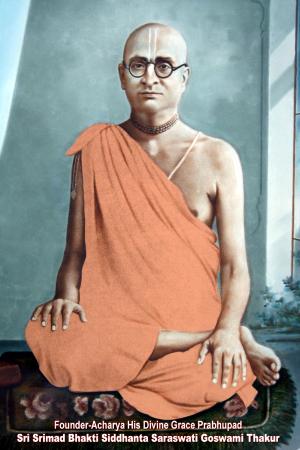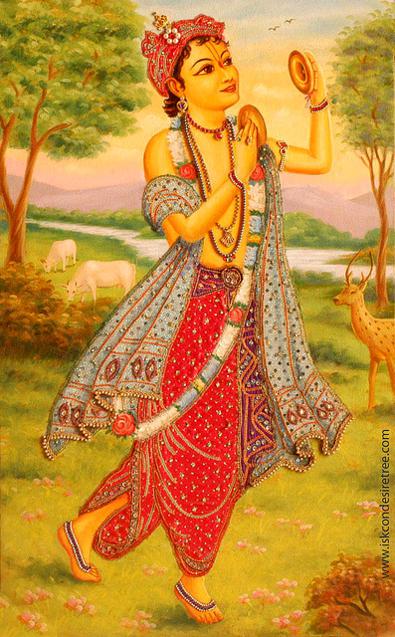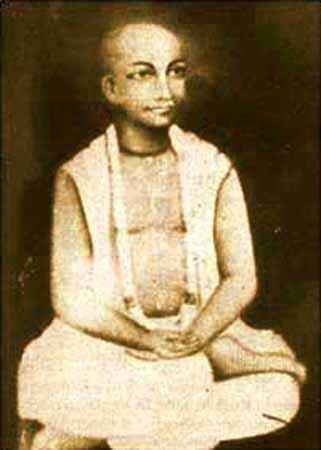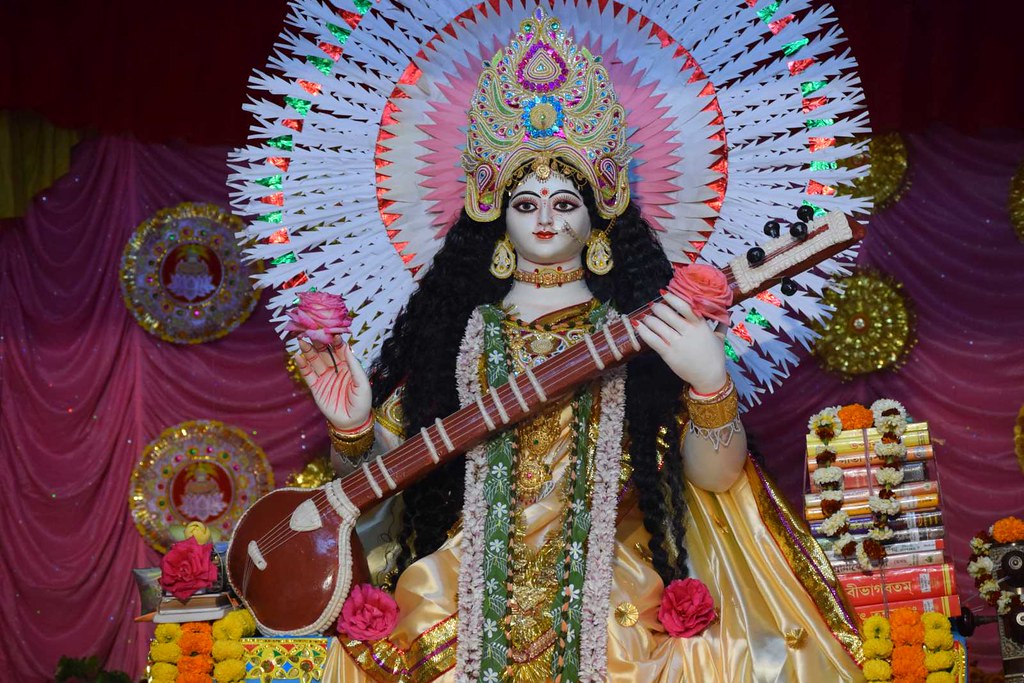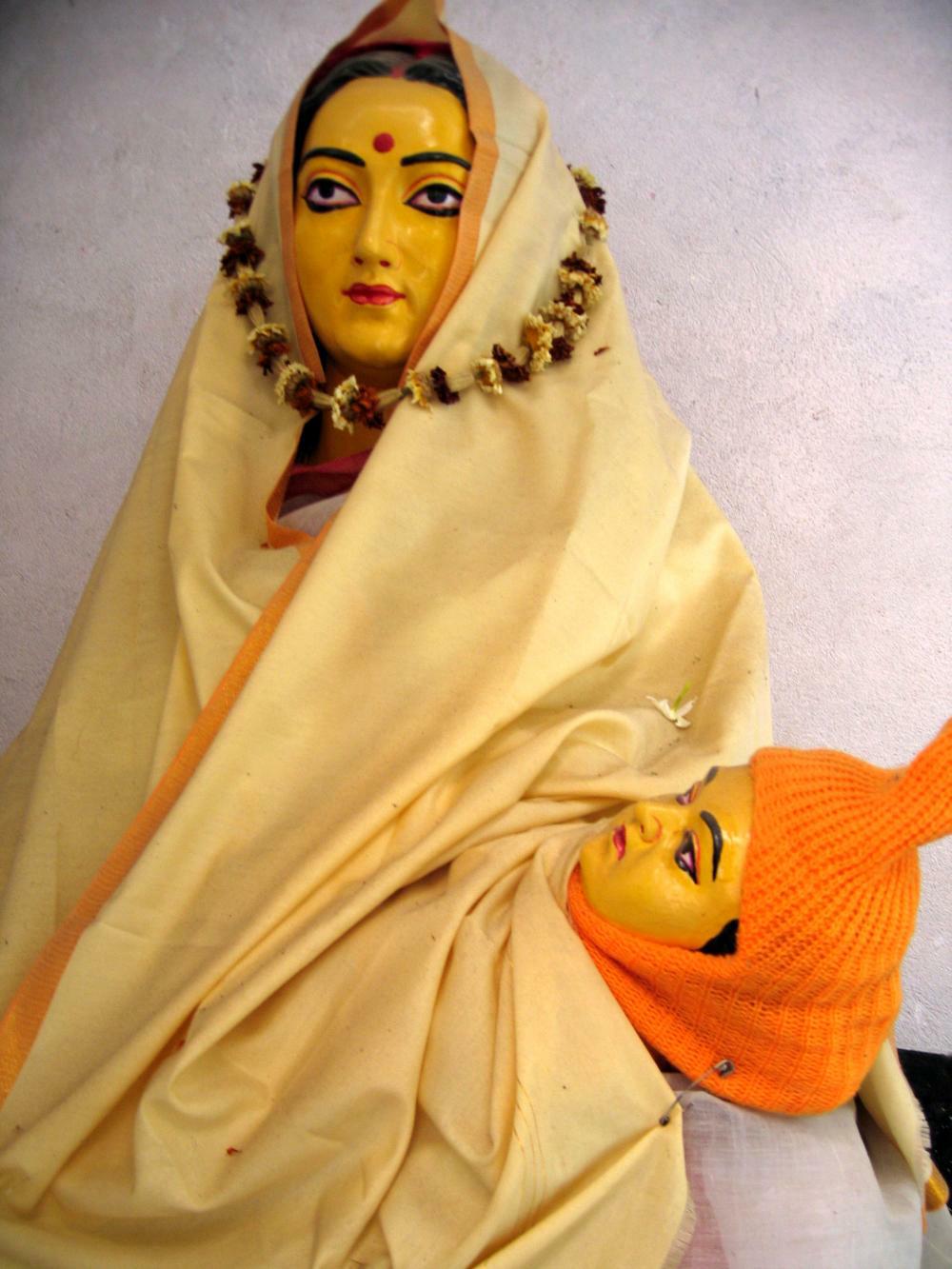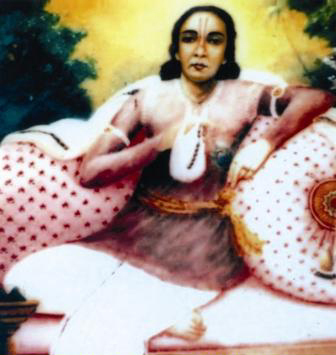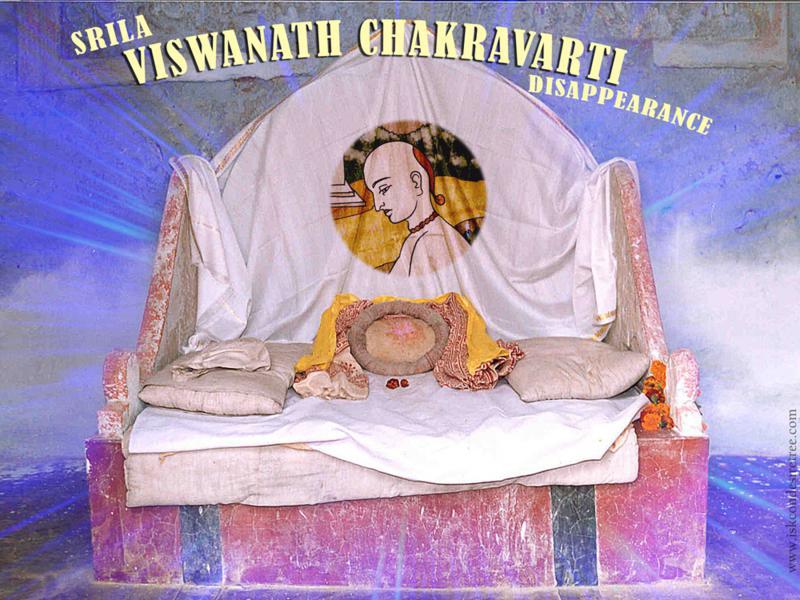During the time of Srila Bhaktivinoda Thakura’s stay on this planet the pure religion of Vaishnavism taught by the Supreme Lord Sri Krishna Caitanya Mahaprabhu was essentially lost and had come to be considered of the degrading standard of simply a sex religion, or at best a cult of religious fanaticism and sentimentalism. The Thakura was very sad in his heart to see this and with a desire to present the actual teachings of Sri Caitanya, he wrote and published many books in Bengali, Sanskrit and English which conclusively presented to the world and to the people of India specifically the real teachings of Sri Caitanya Mahaprabhu and His genuine followers. He also traveled to many parts of India preaching and giving lectures to many people whose hearts became changed by seeing his pure character and shining example. Thakura Bhaktivinoda practically single-handedly revived the pure movement of Nama-sankirtana (the congregational chanting of the holy names of God) and presented the glorie
All Posts (4030)
"The twenty-third and twenty-fourth prominent devotees of Nityananda Prabhu were Sadasiva Kaviraja and his son Purusottama dasa, who was the tenth gopala. Since birth, Purusottama dasa was merged in the service of the lotus feet of Lord Nityananda Prabhu, and he was always engaged in childish play with Lord Krsna." [C.C. Adi 11.8-39]
"Sri Sadasiva Kaviraja was extremely fortunate. His son's name was Sri Purusottama das. He was never externally conscious of his material body. Nityananda Candra enacted many pastimes from within his heart." [C.B. Antya 5/741-742]
Sri Purusottama Thakura had three main disciples: Sri Madhavacarya, Sri Yadavacarya and Devakinandana dasa, who were born in Kulina brahmana families. Madhavacarya married Nityananda Prabhu's daughter, Ganga-devi. Devakinandana was the author of the book Vaishnav-vandane. Purusottama Thakura's Sripat was previously at Sukhasagar. Now his Deities are at Candriya Gram.
This temple is called Vasu-Jahnava Pat. Perhaps this is due
There are various festivities where Lord Krishna’s rasa lila is celebrated – this festival being just one of them. The purnima or full moon of Damodara month is the second full moon of the autumn season, and rasa lila is again celebrated.
This second rasa yatra is celebrated more in Bengal, whereas the first one is celebrated more in Vrindavana. On this day one should perform full worship of Radha and Krishna with many flowers, and place them in a rasa mandapa surrounded by the gopis.
Sri Krishna Vasant Rasa is similar excepting that it is in the Spring (Vasant), at this time everyone dresses in yellow. On this full moon night the devotees usually leave out pots of sweet rice payasam for the Lord to enjoy during His rasas.
Pastimes of Narottama Dasa Thakura
by Srila Narahari Chakravarti (excerpted from Sri Narottama Vilasa)
I take refuge at the lotus feet of Lokanatha Prabhu, who is completely indifferent to the pains and pleasures of this material world. His mercy was fully realized only by the great scholar Narottama dasa. All glories to Narottama dasa Thakura, the beloved disciple of Lokanatha Goswami. How the illustrious Narottama took his birth in the house of Krishnananda Datta, the elder brother of Sri Purusottama, I dare not discuss elaborately here. However, for your pleasure, I shall give a brief description.
One day while Chaitanya Mahaprabhu was dancing with his associates during sankirtana, He suddenly looked in the direction of Sri Kheturi village. A peculiar look appeared on His face, tears whelmed up in His eyes, and He cried out the name "Narottama! Narottama!" again and again. The ocean of mercy Nityananda Raya shouted in joy, and Haridasa, Vakreshvara, and others were inexplicably filled
From Caitanya Bhagavata, Adi-lila, Chapter Nine
Chapter Summary
This chapter describes the childhood pastimes of Nityananda up to his twelfth year, during which time he re-enacted the divine pastimes of Krsna, Rama, Vamana, and the other avataras of Vishnu. This chapter also describes his tour of different holy places which continued until his twentieth year.
On the order of Gaura Krsna, Ananta Deva had already made his appearance in the village of Ekacakra in Radades. In this way, Nityananda Prabhu appeared like the moon from the sea of the womb of Padmavati, the wife of Hadai Oja. And just like the rising moon, he dispelled all the darkness covering the land of Radha by his auspicious appearance. As a child, Nityananda constantly played with his boyhood friends imitating the pastimes of Krsna.
Once, his friends took the role of the assembly of gods, who were desirous of petitioning the Lord to relieve the burden of evil oppressing the Earth. Nityananda Prabhu too
"So this is position. Therefore, because we are Krsna conscious, we are servants of God, therefore it is our duty to save this human civilization. You see. Krsna wants it. ...
...So there is the necessity of war with the demons..." Srimad-Bhagavatam Lecture 1.2.14 Los Angeles, August 17, 1972
So, as i have been saying despite so much opposition from cowards, you cannot sit on your ass ringing bells and think you are doing Krsna any service. Srila Prabhupada is unlike all the others, he wants full revolution from top to bottom.

Varahadeva is the boar incarnation Sri Krsna. He assumed the form of a boar to lift the drowning planet earth from the Garbhodaka Ocean with His tusks.
The demon Hiryanyaksa had thrown the planet earth into this ocean, but the Lord stabbed the demon with His tusks and saved the earth. After describing the appearance of the white Boar Incarnation that had appeared during the Svayambhuva devastation, Maitreya next described the red Boar Incarnation that had appeared during the Chakshusha devastation. Maitreya related these pastimes to Vidura in the same manner in which he had heard them long ago when Lord Brahma had narrated them to the demigods.
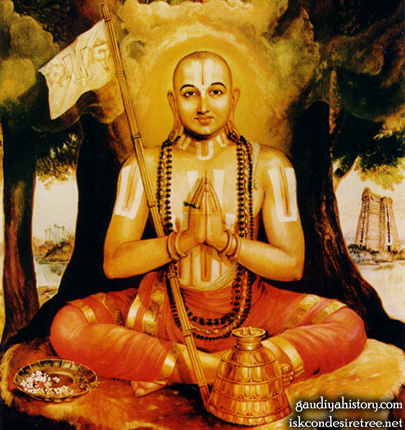 Ramanujacharya
RamanujacharyaWhen the religion of the Vedas became weakened due to the influence of less intelligent men who blindly performed ritualistic ceremonies and wantonly killed animals in the name of Vedic injunctions, Buddha appeared on the scene as a great reformer. Totally rejecting the Vedic literature and substituting his rational, atheistic views, Buddha advocated the path of ahimsa, (nonviolence and nirvana-the negation of reality as we know it) as the ultimate goal of life. Soon after, the philosophy of Shankaracharya overpowered Buddhism and spread throughout India.
The authority of the Upanishads and other Vedic literature were revived by Shankara and employed as weapons to fight the Buddhist doctrine. Interpreting the Vedas to draw a particular conclusion, Shankara established the doctrine of non-dualism, adwaita-vedanta, stating that all living entities were on an equal level with God. He prominently stressed those texts which afforded an answer to the rationalistic atheism
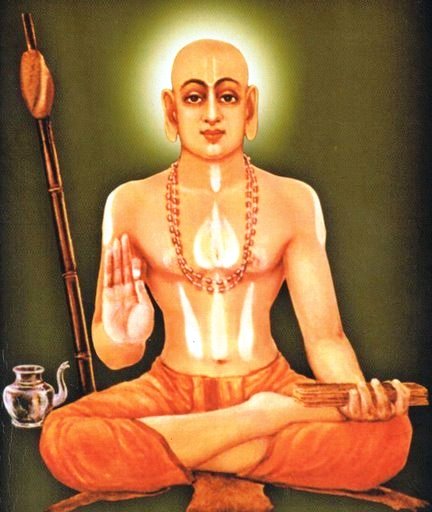
Madhvacharya took diksha at age five, sannyasa at twelve and left home. He appeared with a mission to fight and defeat Sankara's Mayavada (impersonal) philosophy. By giving a pure interpretation of Vedanta-sutra he promoted pure theism. He named his innovative shastric explanation dvaita-dvaita-vada (pure dualism). (In the image: Shrila Madhvacharya).
Shri Madhvacharya appeared in 1238 A.D. near Udupi, Karnataka in South India. He was considered an incarnation of Vayu (wind god). He had an unusually strong physique and extraordinary intellectual power. Once a fierce Bengali tiger attacked Madhvacharya's sannyasa disciple, Satya Tirtha. Madhvacharya wrestled the tiger and sent him away with his tail between his legs. Madhvacharya took diksha at age five, sannyasa at twelve and left home. He appeared with a mission to fight and defeat Sankara's Mayavada (impersonal) philosophy. By giving a pure interpretation of Vedanta-sutra he promoted pure theism. He named his innovative shastric ex
Bhismastami is the appearance anniversary of Bhismadeva, the “grandfather” of the Pandavas. Bhishma's name in his boyhood was Devavrata.
Geneology:
From Vishnu were descended in the following order – Brahma-Atri-Candra-Budha – Pururavas – Ayus – Nahusha- Yayati – Puru – Janamejaya – Prachinvaa – Pravira – Namasyu – Vitabhava – Shundu – Bahuvidha – Samyati – Rahovadi – Raudrasva – Matinara – Santurodha – Dushyanta – Bharata – Suhotra – Gala – Gardda – Suketu – Brhatksetra – Hasti – Ajamidha – Riksha – Samvarana – Kuru – Jahnu – Suratha – Vidaratha – Sarvabhauma – Jayatsena – Ravyaya – Bhavuka – Chakroddhata – Devatithi – Riksha – Bhima-Pratipa-Shantanu-Bhishma.
Birth and Boyhood:
Bhishma's name in his boyhood was Devavrata. He was the eighth son of Shantanu, a king of the lunar dynasty and Gangadevi. This boy was the human embodiment of Dyau, one of the Ashthavasus. Shantanu, his father was the re-birth of another king, Mahabhisheka. The story concerning this is given in the Mahabharata
He is a disciple of Madhavendra Puri, and constitutes one of the figures amongst the Pancatattva. He is the combined incarnation of Lord Mahavishnu and Lord Sadashiva. He was born in a varendra brahmana family on the seventh day of the bright fortnight in the month of Magha, 1355 Saka (1433 AD), in the village named Lauda in Srihatta.
According to Bangabhasa O Sahitya, Advaita Prabhu was born in 1434 AD and met Vidyapati in 1458 AD. Advaita's former name was Kamalaksha (Kamalakanta) Vedapancanana. His two wives were Sita Devi and Sri Devi. Acyutananda was born of Sita Devi (1425 Saka 1503 AD), followed by Krsnadasa, Gopala, Balarama, Svarupa, and Jagadisa Misra. While Sri
Devi gave birth to one son named Syamadasa (Premavilasa 24).
From Lauda, Advaita Prabhu migrated to the village of Navahatta and later to Santipura. He also had a house at Navadvipa. In 1480 Saka (1558 AD), at the age of 125 years (i.e. 25 years after the disappearance of Lord Gauranga) Advaita Prabhu returned to the
The Supreme Lord Visnu has three different Saktis: Sri, Bhu, and Nila. Sri Visnupriya is the internal potency known as Bhu-sakti. She appeared in Gaura-lila to assist Sri Caitanya Mahaprabhu with his mission of spreading the holy name of Krsna.
In Nabadwipa-dhama there lived a brahmana named Sanatana Misra, who was an extremely exalted Visnu-bhakta. He was a pious and generous brahmana as well, and used to feed, clothe and shelter many people. He was famous as the king of panditas. In fact, in Dvapara-yuga, he had been a king named Satrajit. As a result of his pure devotion to Visnu he was blessed with a beautiful daughter who was rich in all good qualities. From her early childhood, Visnupriya devi used to bathe in the Ganges three times daily. She was devoted to her parents and carefully followed the scriptural principles, and performed puja, arcana, and served the tulasi tree, while observing many different vows of austerity and piety.
Every day, when Visnupriya went to v
O jiyat kaisora-caitanyo
murti-matya grihasramat
lakshmyarcito ’tha vag-devya
disam jayi-jaya-cchalat
TRANSLATION
Long live Lord Caitanya Mahaprabhu in His kaisora age! Both the goddess of fortune and the goddess of learning worship Him. The goddess of learning, Sarasvati, worshiped Him in His victory over the scholar who had conquered all the world, and the goddess of fortune, Lakshmi devi, worshiped Him at home. Since He is therefore the husband or Lord of both goddesses, I offer my obeisances unto Him. (Sri Chaitanya Charitamrta. Adi lila 16:3.)
kamais tais tair hrita jnanah
prapadyante ’nya-devatah
tam tam niyamam asthaya
prakritya niyatah svaya
“Those whose minds are distorted by material desires surrender unto demigods and follow the particular rules and regulations of worship according to their own natures.” (Bg. 7.20)
This is the first day of spring in India. On the fifth day of the waxing moon one should celebrate the coming of spring to Vrindavana by offering Krishna many types of leaves and flowers, and fresh shoots of sprouting grasses.
In places like Vrindavan, Mayapur, Jagannath Puri and Udupi many of the women folk dress in yellow also. As it is the first day of spring many fertility rites are performed at this time – for the family, for the women folk, for the crops, for the cows, etc. It’s a very festive time.
Many new projects are begun, weddings performed…….
fields of yellow mustard flowers growing
This is the first day of spring in India. On the fifth day of the waxing moon one should celebrate the coming of spring to Vrindavana by offering Krishna many types of leaves and flowers, and fresh shoots of sprouting grasses.
In places like Vrindavan, Mayapur, Jagannath Puri and Udupi many of the women folk dress in yellow also. As it is the first day of spring many fertility rites are performed at this time – for the family, for the women folk, for the crops, for the cows, etc. It’s a very festive time.
Many new projects are begun, weddings performed…….
fields of yellow mustard flowers growing
Around this time one very wealthy Seth underwent great austerity by walking to Badarikasrama in the Himalayas. Arriving there he very reverently worshiped Sri Badrinarayana and offered much wealth at His lotus feet. That night as he slept there, he had a dream in which Sri Badarinarayana instructed him to proceed to Vraja, where he should present all his wealth to Sri Raghunatha Dasa Gosvami, who was residing at Aritgram. "If he declines to accept it, then you can mention My name and remind him about renovating Radha-kunda and Shyama-kunda."
That Seth was very happy to have seen such a wonderful dream and after returning to his home he very joyfully set out for Vraja. There he met Raghunatha d
Shri Mukunda Dasa, Shri Madhava Dasa and Shri Narahari Sarakara Thakura were three brothers who lived in Shri Khanda. Shri Mukunda Dasa Thakura's son was Shri Raghunandan Thakura. Mukunda Dasa Thakura was the doctor in the court of the muslim king. He was always absorbed in Krishna, whatever work he did.
An example of this is found in what happened to Mukunda Dasa one day when he went to the court of the king to give him some medical advice. The king was seated on an elevated throne. Mukunda Dasa sat before him, a little lower, on a half-elevated seat, and began inquiring about his health. At taht time a servant came with a large peackock fan to fan the king. The sight of peacock feathers filled Mukunda with a deep memory of Krishna's pastimes. He fainted. When the king saw Mukunda laying on the ground he was alarmed. He thought, "Is he dead?" Gradually they managed to bring him back to consciousness. The king asked him, "What is the nature of your disease?" Shri Mukunda Dasa
A disciple of Sri Madhavendra Puri, Pundarika Vidyanidhi was Sri Gadadhara Pandit's guru, and an intimate friend of Svarupa Damodara.
Once in Jagannatha Puri, Pundarika Vidyanidhi met Svarupa Damodara after a long separation. In a joyful mood of friendship Pundarika and Svarupa wanted to take the dust from each other's feet. A scuffle began as they tried to simultaneously catch the feet of one another, but at the same time, avoid having their own feet caught. Both being quite strong, neither won. But Sri Gauranga enjoyed their sporting play and everyone laughed.
Pundarika Vidyanidhi has other names—Sri Vidyanidhi, Acaryanidhi, Bhaktyanidhi, and Premanidhi (given by Lord Caitanya). "Simply by hearing his name," said Sri Gaura, "the whole world becomes purified." Premanidhi's pure devotion caused Sri Caitanya Mahaprabhu to sometimes cry profusely and call out loudly, "Bop, (father) Pundarika! Pundarika is My father, My dearmost friend. When will I see him again?" Pundarika Vidya
Vishvanatha Chakravarti Thakura was one of the most prominent, influential, and prolifically literate teachers in the disciplic succession of Krishna devotees. He appeared in 1662 in the village of Devagram, Bengal. He received initiation from Ramana Chakravarti, and his name after taking sannyasa (renounced life) was Hari Vallabha Goswami.
Srila Bhaktisiddhanta Saraswati Thakura, a later acharya in the disciplic succession, writes: “To serve the feet of Narottama dasa Thakura was the only desire of Vishvanatha Chakravarti Thakura, who was the fourth acharya in disciplic succession from Narottama dasa.” Srila Vishvanatha Chakravarti Thakura wrote more than forty Sanskrit books, including commentaries on Bhagavad-gita, Srimad-Bhagavatam, and the writings of the six Goswamis of Vrindavan.
Srila Prabhupada regularly referred to Vishvanath Chakravarti Thakura's Srimad-Bhagavatam commentaries while writing his own purports.
